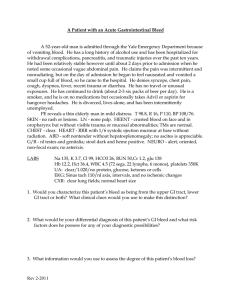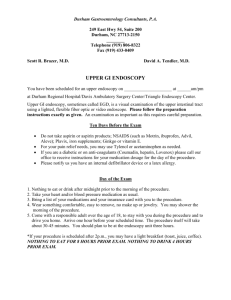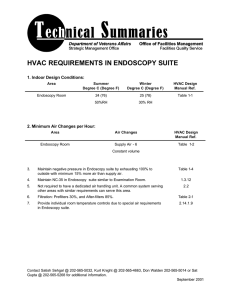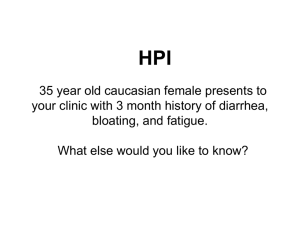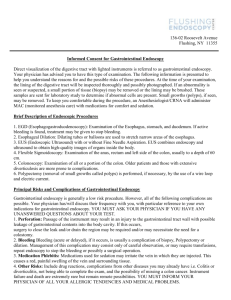Level 2 Endoscopy KEY POINTS: • It is widely accepted that
advertisement
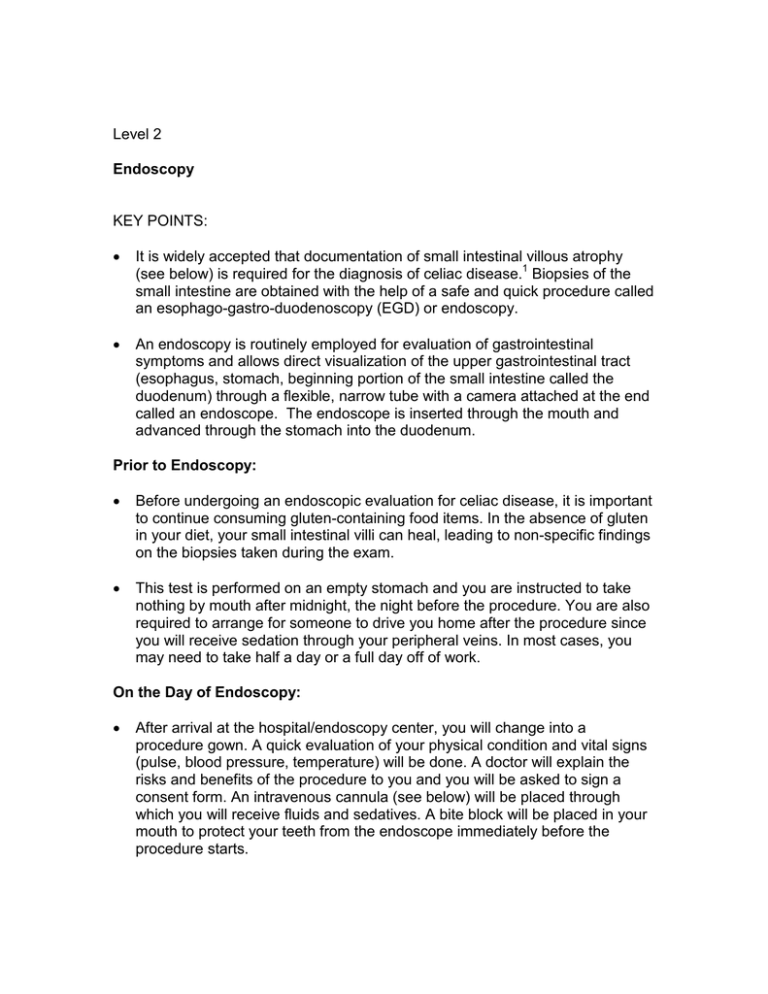
Level 2 Endoscopy KEY POINTS: • It is widely accepted that documentation of small intestinal villous atrophy (see below) is required for the diagnosis of celiac disease.1 Biopsies of the small intestine are obtained with the help of a safe and quick procedure called an esophago-gastro-duodenoscopy (EGD) or endoscopy. • An endoscopy is routinely employed for evaluation of gastrointestinal symptoms and allows direct visualization of the upper gastrointestinal tract (esophagus, stomach, beginning portion of the small intestine called the duodenum) through a flexible, narrow tube with a camera attached at the end called an endoscope. The endoscope is inserted through the mouth and advanced through the stomach into the duodenum. Prior to Endoscopy: • Before undergoing an endoscopic evaluation for celiac disease, it is important to continue consuming gluten-containing food items. In the absence of gluten in your diet, your small intestinal villi can heal, leading to non-specific findings on the biopsies taken during the exam. • This test is performed on an empty stomach and you are instructed to take nothing by mouth after midnight, the night before the procedure. You are also required to arrange for someone to drive you home after the procedure since you will receive sedation through your peripheral veins. In most cases, you may need to take half a day or a full day off of work. On the Day of Endoscopy: • After arrival at the hospital/endoscopy center, you will change into a procedure gown. A quick evaluation of your physical condition and vital signs (pulse, blood pressure, temperature) will be done. A doctor will explain the risks and benefits of the procedure to you and you will be asked to sign a consent form. An intravenous cannula (see below) will be placed through which you will receive fluids and sedatives. A bite block will be placed in your mouth to protect your teeth from the endoscope immediately before the procedure starts. Endoscopy: • The procedure will be carried out in a darkened room after you have received adequate sedation. A thin, flexible endoscope will be inserted into your mouth and advanced to your duodenum under direct visualization. After careful inspection of the tissue of your small intestine, multiple biopsies (two biopsies from the duodenal bulb and at least six biopsies from the second portion of the duodenum)1 will be obtained, using biopsy forceps. • The test lasts anywhere between 10 – 15 minutes in most cases. Immediately after the test you can expect to receive a printed report with pictures of your gastrointestinal tract and recommendations, if any. • The biopsies obtained during your endoscopy are evaluated by pathologists for the presence of celiac disease. Most skilled pathologists can identify changes in the tissue of your small intestine that are characteristic of celiac disease. In certain cases, however, findings of celiac disease can overlap with other gastrointestinal illnesses. In such cases the value of a pathologist with skilled training and experience in gastrointestinal pathology cannot be overemphasized. Post Endoscopy: • After the procedure is completed, you will be brought to the recovery area. While the peak effect of sedation occurs during the exam, residual grogginess can occur for the next few hours. You will be able to eat and drink after the exam and resume your daily activities. However, due to the effect of sedation, you are strongly urged to refrain from operating machinery, signing important documents such as legal documents, or driving a car. As a result, you will need to arrange for someone to bring you home. Possible Risks: • While an endoscopy is a relatively safe procedure, in extremely rare cases patients can have complications such as a tear called a perforation,an infection, and/or bleeding from the procedure. In some cases, these complications may require surgical correction. In The Future: Scientists and clinicians are working hard to eliminate the need for endoscopy in the diagnosis of celiac disease. The ultimate goal of reducing the cost and burden of celiac disease diagnosis through the use of non-invasive tests is generally agreed upon. A consensus guideline produced by the European Society of Pediatric Gastroenterology, Hepatology, and Nutrition recently proposed a triple test strategy to avoid intestinal biopsies for children.2 Candidates for diagnosis without biopsy should be symptomatic, have an IgA tTG level greater than 10-fold above the upper limit of normal, test positive for antiEmA in a separate blood sample, and have the HLADQ2 haplotype. Recent World Gastroenterological Association guidelines recommended a no-biopsy algorithm for countries with limited health care resources.3 The table below summarizes comparative characteristics of various societies’ guidelines: Guideline Guideline design (population) Intestinal biopsy Recommended blood tests Comments and remarks References Expert consensus ESPGHAN (children) Anti-tTG, anti-EmA, total Not IgA, and tests for HLAAllows for diagnosis without mandatory DQ2 and HLA-DQ8 biopsy under certain conditions 2 WGO Expert consensus (adults) Not Anti-tTG, anti-EmA and mandatory anti-DGP Uses a diagnostic cascade based on available local resources. Allows for diagnosis without biopsy under certain conditions 3 ACG Expert consensus evidencebased (children and adults) Mandatory Anti-tTG and anti-DGP Recommends IgG DGP antibodies in children <2 y 1 BSG Expert consensus evidencebased (adults) Anti-tTG, anti-EmA, and Mandatory anti-DGP Holds to the position that serology cannot replace biopsy 4 ACG, American College of Gastroenterology; BSG, British Society of Gastroenterology; ESPGHAN, European Society of Pediatric Gastroenterology, Hepatology and Nutrition; WGO, World Gastroenterological Organization. TAKE HOME MESSAGES: 1. Endoscopy with biopsy is recommended for most people to confirm celiac disease before changing their diet. 2. Multiple biopsies (two biopsies from the duodenal bulb and at least six biopsies from the second part of the duodenum) are recommended during an endoscopy to evaluate for celiac disease. 3. Since findings of celiac disease can overlap with other gastrointestinal illnesses, it is important that the pathologist reading the biopsy has skilled training and experience in gastrointestinal diseases. Key Words: Atrophy: a decrease in size or wasting away of a body part or tissue Cannula: a thin plastic tube for insertion into the body to draw off fluid or to introduce medication. References: 1. Rubio-Tapia A, Hill ID, Kelly CP, Calderwood AH, Murray JA. ACG Clinical Guidelines: Diagnosis and Management of Celiac Disease.: Am J Gastroenterol. 2013 May;108(5):656-76. 2. Husby S, Koletzko S, Korponay-Szabo IR, et al. European Society for Pediatric Gastroenterology, Hepatology, and Nutrition guidelines for the diagnosis of coeliac disease. J Pediatr Gastroenterol Nutr 2012;54:136– 160. 3. Bai JC, Fried M, Corazza GR, et al. World Gastroenterology Organisation global guidelines on celiac disease. J Clin Gastroenterol 2013;47:121– 126. 4. Bardella MT, Fredella C, Prampolini L, et al. Body composition and dietary intakes in adult celiac disease patients consuming a strict glutenfree diet. Am J Clin Nutr 2000;72:937–939. Revision Date: 3/24/2016 Author: Kumar Pallav MD, Abhijeet Yadav MD Editors: Melinda Dennis, MS, RD, LDN and Rupa Mukherjee MD
